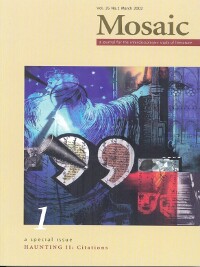Issue 35.1
Overview

Special Issue: Haunting II: Citations
Published: March 2002
View the issue introduction or see the issue summary and contents below.
11 essays, totalling 224 pages
$17.95 CAD
In Part II of the special issue on haunting, the essays emphasize the theme of citations. This issue opens with an interview of John P. Leavey, Jr., followed by ten essays covering the Middle Ages to contemporary periods. A particular emphasis is given to ghosts and the ghost story, mortality, and questions of metaphysics. The essays include examinations of medieval manuscripts, witchcraft and the theatre, trauma and enslavement, and pictures and gothic literature.
Translation/citation: An Interview with John P. Leavey Jr.Dawne McCance On 14 February 2001, Dawne McCance (DM) interviewed John P. Leavey Jr. (JL) at the University of Florida, Gainesville. | |
Citation’s Haunt: Specters of DerridaJulian Wolfreys This essay addresses the relationship between speciality, citation, and the ghost writing that takes place in the name and institution of scholarship. Responding to places where Jacques Derrida implicitly or explicitly connects quotation and haunting, the essay considers the extent to which academic writing is a manifestation of a “spectropoetics.” | |
“Like People You See in a Dream”: Penelope Lively and the Ethnographic Ghost StoryAnthony Purdy Lively’s The House in Norham Gardens examines “primitive” artifacts deployed as chronotopic motifs and cross-cultural shifters in the ethnographic ghost story. Drawing on anthropology of the discipline’s “freezing” of the “primitive” in a timeless past, this essay foregrounds the haunting of the post-colonial by its colonial ghosts. | |
The Concept as Ghost: Conceptualization of the Uncanny in Late-Twentieth-Century TheoryAnneleen Masschelein Ongoing conceptualization of the Freudian uncanny (das Unheimliche) in the late twentieth century is marked by the ambiguity that prevails in current theoretical and critical movements. The complexity of the conceptualization is briefly demonstrated in this essay with reference to deconstructive architecture. | |
Life and Death, Reader and Page: Mirrors of Mortality in English ManuscriptsSusanna Greer Fein The Three Living and the Three Dead, a mediaeval icon of the macabre, survives in English manuscripts in only five illuminations (two with English verses) and an alliterative poem. The motif works as multiple speculum, its six haunted figures engaged in a reciprocal specular encounter, while it beckons a reader to take his or her place in its temporal hall of mirrors. | |
Nursing Nothing: Witchcraft and Female Sexuality in The Winter’s TaleKirstie Gulick Rosenfield The text of The Winter’s Tale associates witchcraft with voracious sexuality, perverted maternity, and inappropriate speech but then suggests that performance is witchcraft. Shakespeare’s reappropriation of witchcraft as a metaphor for theatre can be read as a critique of anti-theatricality and as a cultural narrative linking femininity and birthing to art. | |
Trauma and the Specters of Enslavement in Morrison’s BelovedR. Clifton Spargo Reading Beloved specifically, this essay considers the explicit tension between trauma as a trope for recovered history and those therapeutic, empiricist-minded narratives that require a subject to progress beyond and locate herself rationally outside the traumatic moment. | |
Between Worlds: Class Identity and Suburban Ghost Stories, 1850 to 1880Lara Baker Whelan Many Victorian suburban ghost stories address anxieties about class-linked space. This essay analyzes four themes in these narratives: the use of suburban setting to highlight class instability; the ghost as threat to middle-class culture; the middle-class male who nullifies the threat of the undomesticated/supernatural; and the ghost as disciplinary “overseer.” | |
Charles Wright, Giorgio Morandi, and the Metaphysics of the LineBonnie Costello The Pulitzer Prize-winning American poet Charles Wright has had a career-long interest in the work of Italian modernist painter Giorgio Morandi. Morandi has influenced not only Wright’s representational style and subject matter hut also his approach to free verse lineation. For Wright, the kinetic energy between lines and white space maps out the metaphysical desire that words and images labour to describe. | |
A Pictorial Counterpart to “Gothick” Literature: Fuseli’s The NightmareJohn F. Moffitt Painted in 1781, then often reproduced, Fuseli’s The Nightmare became widely influential. Its real context is the “Demonism” current in contemporary “Gothick” literature, and the key to this is Fuseli’s haunting “incubus,” first described in the Malleus Maleficarum. | |
Caves: Technology and the Total Artwork in Reich’s The Cave and Beckett’s Ghost TrioEric Prieto This essay studies two multimedia pieces that use recording technology to meld music, text, and image into extraordinarily unified works of art. The author argues that such innovative solutions to the problem of unity make these pieces valuable points of reference for contemporary multimedia aesthetics. |